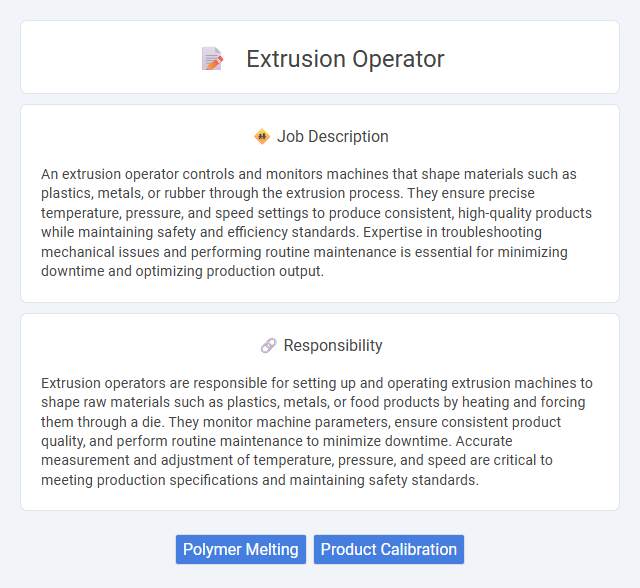
An extrusion operator controls and monitors machines that shape materials such as plastics, metals, or rubber through the extrusion process. They ensure precise temperature, pressure, and speed settings to produce consistent, high-quality products while maintaining safety and efficiency standards. Expertise in troubleshooting mechanical issues and performing routine maintenance is essential for minimizing downtime and optimizing production output.
Extrusion operator roles often require individuals to handle repetitive tasks and operate heavy machinery, which may challenge those with physical limitations or low tolerance for routine work. Candidates with strong attention to detail, mechanical aptitude, and the ability to maintain focus in noisy environments are more likely to excel. People adaptable to shift work and safety protocols have a higher probability of suitability for this position.
Qualification
Extrusion operators must possess technical skills in operating and maintaining extrusion machinery, with strong knowledge of plastic and metal extrusion processes. Qualifications typically include a high school diploma or equivalent, coupled with vocational training or certification in machinery operation or manufacturing technology. Proficiency in troubleshooting equipment malfunctions and ensuring quality control standards is essential for successful performance in extrusion operations.
Responsibility
Extrusion operators are responsible for setting up and operating extrusion machines to shape raw materials such as plastics, metals, or food products by heating and forcing them through a die. They monitor machine parameters, ensure consistent product quality, and perform routine maintenance to minimize downtime. Accurate measurement and adjustment of temperature, pressure, and speed are critical to meeting production specifications and maintaining safety standards.
Benefit
Working as an extrusion operator may likely offer benefits such as steady employment in manufacturing, opportunities for skill development in operating advanced machinery, and potential for overtime pay in busy production cycles. The role might also provide access to workplace safety programs and health benefits depending on the employer. Job stability and the chance to contribute to product quality could be additional advantages for individuals in this position.
Challenge
The Extrusion operator role likely presents challenges in maintaining consistent product quality while managing high-speed machinery. Precision and quick problem-solving skills may be crucial to address equipment malfunctions or material inconsistencies in real-time. Adapting to evolving production demands and ensuring safety compliance could also frequently test the operator's technical expertise and attentiveness.
Career Advancement
Extrusion operators can advance their careers by gaining expertise in advanced machinery operations and process optimization, leading to supervisory or technical specialist roles. Developing skills in quality control, troubleshooting, and automation increases eligibility for promotions within manufacturing plants. Continuous training and certifications in extrusion technology and production management significantly enhance career growth opportunities in the plastic and metal manufacturing industries.
Key Terms
Polymer Melting
Extrusion operators specializing in polymer melting expertly control temperature, pressure, and screw speed to ensure consistent melting and flow of polymer materials during the extrusion process. They monitor melt homogeneity using advanced sensors and adjust machine parameters to prevent degradation and maintain product quality. Mastery of polymer thermal properties and equipment calibration is critical for optimizing throughput and minimizing material waste in manufacturing.
Product Calibration
An extrusion operator specializes in maintaining precise product calibration to ensure consistent dimensions and quality during the extrusion process. They monitor equipment settings and adjust variables such as temperature, pressure, and material feed rates to achieve target specifications. Accurate calibration directly impacts the final product's performance, reducing waste and enhancing production efficiency.
 kuljobs.com
kuljobs.com